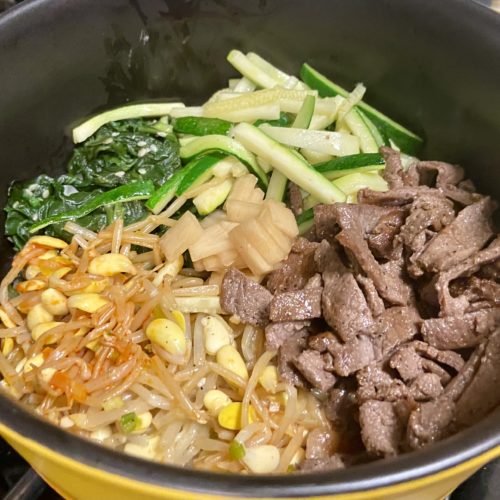
Grilled Mixed Rice (Dulsot Bibimbap)
An iconic Korean dish made easy for home cooking
Equipment
- 1 earthenware pot alt nonstick pot, but you won't get as good of a crisp at the bottom
Ingredients
- 2 cups freshly cooked rice
Zucchini Topping
- 1/2 cup julienned zucchini
- 1/8 tsp salt (just a pinch)
Spinach Topping
- 1 bundle spinach (bundles vary, approx 3 oz of raw greens)
- 1 tsp minced garlic
- 1 tsp sesame oil
- 1/4 tsp salt
- 1 tsp sesame seeds
Additional Toppings (remember all toppings are modifiable)
- kongnamul muchim (prepared bean sprouts)
- pickled daikon
- fried eggs
- salted seaweed
Beef Topping (optional)
- 1/4 lb shaved beef (or finely cut)
- 1 TBSP soy sauce
- 1 tsp garlic powder
- 1/4 tsp black pepper
- 1 tsp sugar (optional) (or sweetener of choice)
- 1 TBSP sake
Bibimbap Sauce (optional)
- 2 TBSP gochujang
- 1 TBSP rice vinegar
- 2 tsp honey (or maple syrup or sugary syrup of choice)
- 2 tsp sesame oil
- 2 tsp garlic powder
- 1/8 tsp salt or to taste
Instructions
Prep Cooking Ingredients
- If you don't have it on hand already, start by cooking the rice. Bibimbap is best with freshly cooked rice.2 cups freshly cooked rice
- First sauté the vegetables. Starting with the zucchini, add 1-2 tsp of cooking oil (olive or avocado is my preference) and cook over medium heat until zucchini's color has become bright green and slightly wilted in texture. Add salt (and pepper if you like) to taste. Remove and set aside.1/2 cup julienned zucchini, 1/8 tsp salt (just a pinch)
- Next we cook the spinach. In the same pan, add another 2 tsp cooking oil and add in the minced garlic. Once fragrant, add the spinach and stir to coat. The spinach will wilt a LOT. Once wilted, drizzle sesame oil and sprinkle the salt. Toss to coat. Remove and set aside.1 bundle spinach, 1 tsp sesame oil, 1/4 tsp salt, 1 tsp sesame seeds, 1 tsp minced garlic
- Beef topping is last. Mix the seasoning ingredients in a separate bowl. In the same pan that you've been using, add in 2 tsp of cooking oil, then add the beef into the pan. Stir to cook evenly. Once most of the pink/red is out of the beef, add the seasoning sauce. Cook the beef in the seasoning sauce until the sauce is evaporated. Remove and set aside.1/4 lb shaved beef, 1 TBSP soy sauce, 1 tsp garlic powder, 1/4 tsp black pepper, 1 tsp sugar (optional), 1 TBSP sake
Assembly Time
- Coat 1 TBSP of sesame oil into an earthenware pot and turn on stove to medium heat. Line the bottom of the pot with the freshly cooked rice, using as much or as little as you prefer (I usually avg about 3/4 cup per person eating). Once the pot starts heating you'll start hearing sizzling sounds from the rice.
- Drizzle additional sesame oil overtop the rice.
- While rice is sizzling, start assembling the bibimbop. Places the various vegetables into different quadrants of the pot, making sure to leave room for the beef (if using). Top with salted shredded seaweed and place the fried egg on top (if using).1/8 tsp salt (just a pinch), kongnamul muchim (prepared bean sprouts), pickled daikon, fried eggs, salted seaweed
- Allow rice to sizzle for 5 minutes.
- Remove pot from heat and serve in pot. Use a spoon to stir the grilled rice from the bottom. Try serving with homemade bibimbap sauce*.2 TBSP gochujang, 1 TBSP rice vinegar, 2 tsp honey, 2 tsp sesame oil, 2 tsp garlic powder, 1/8 tsp salt
Notes
*I highly recommend taking a little extra effort to make the bibimbap sauce. It really elevates the bibimbap meal. Store-bought tends to be too sweet and often has corn syrup. Homemade is very easy and you'll find the sauce can be used as a condiment for many other things.
In my version, I used an unknown earthenware pot I owned (meant for stovetop stews I think more than recipes like this). The Korean stone pots are definitely superior in this kind of dish, but are pretty unique to Korean cuisine and therefore not easily found outside of a Korean market. If you don't have a stone pot, earthenware pots or cast iron are the next best thing with nonstick pots as a last resort.